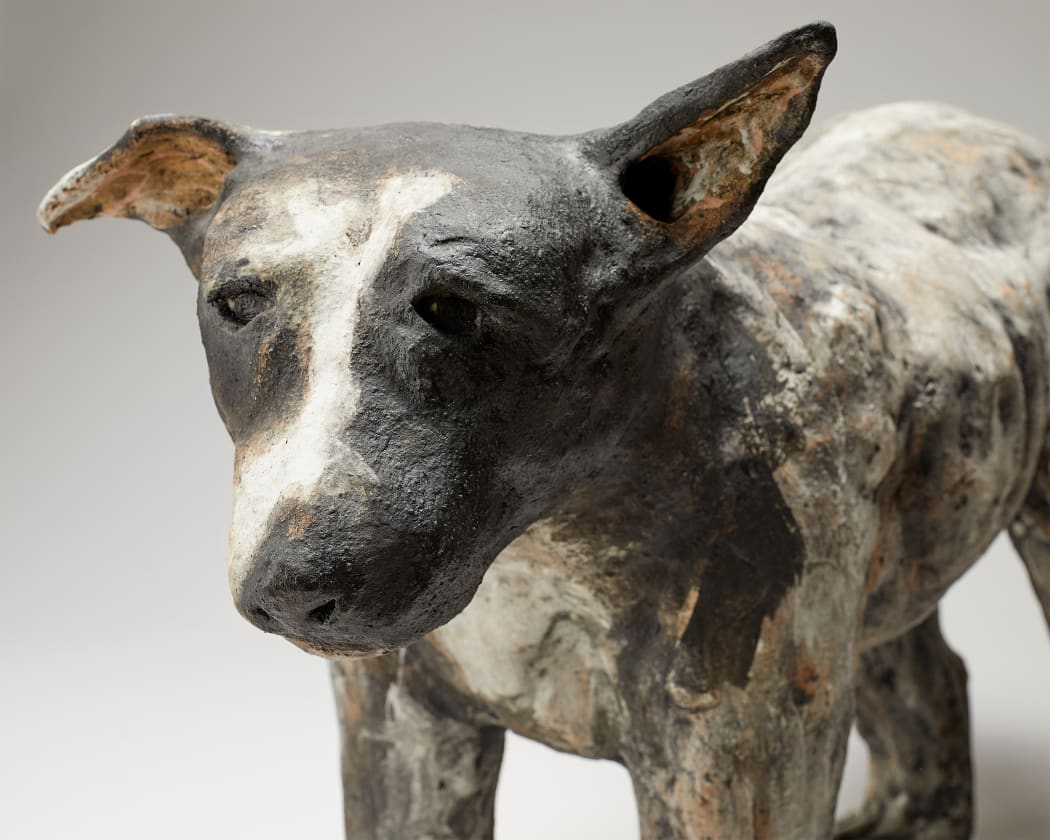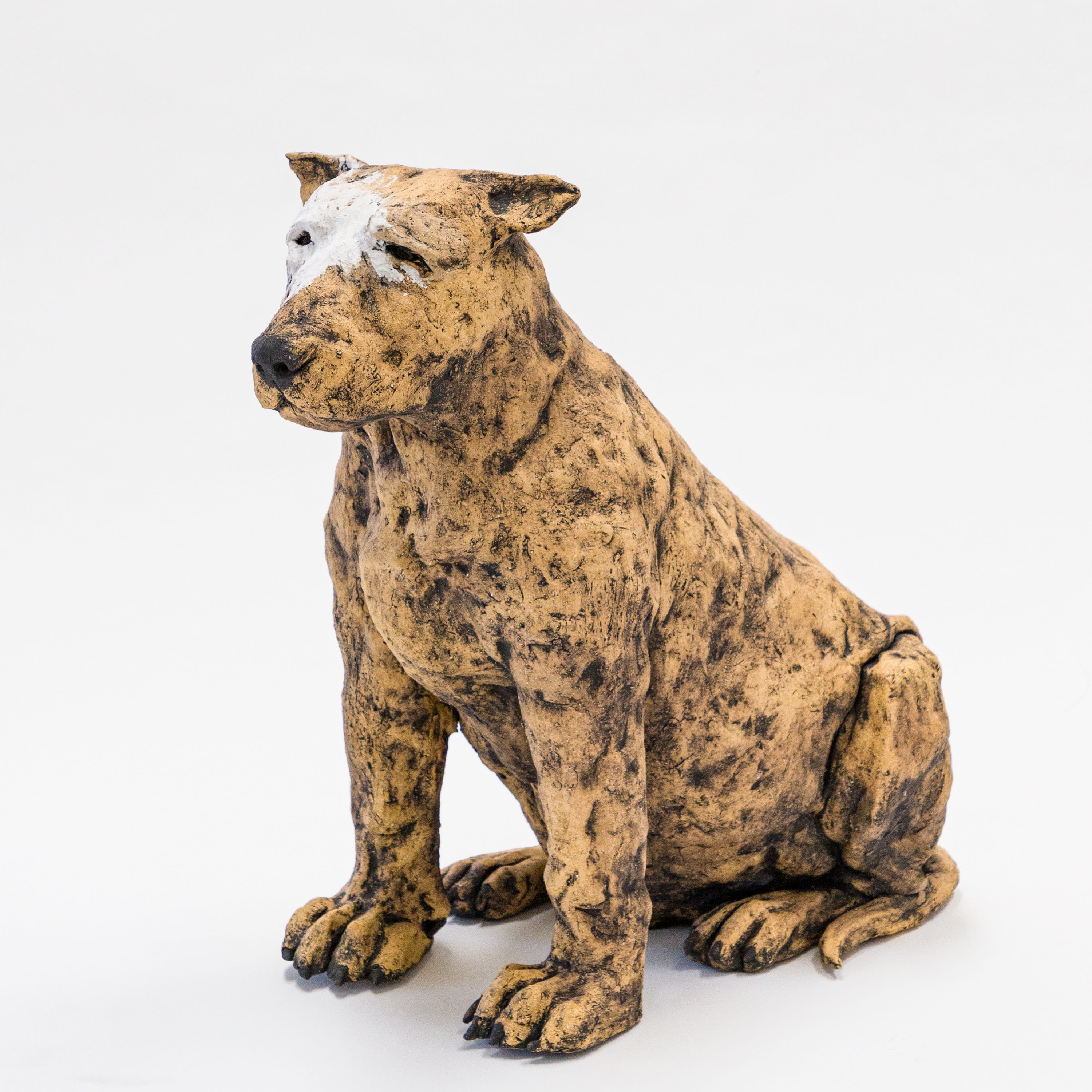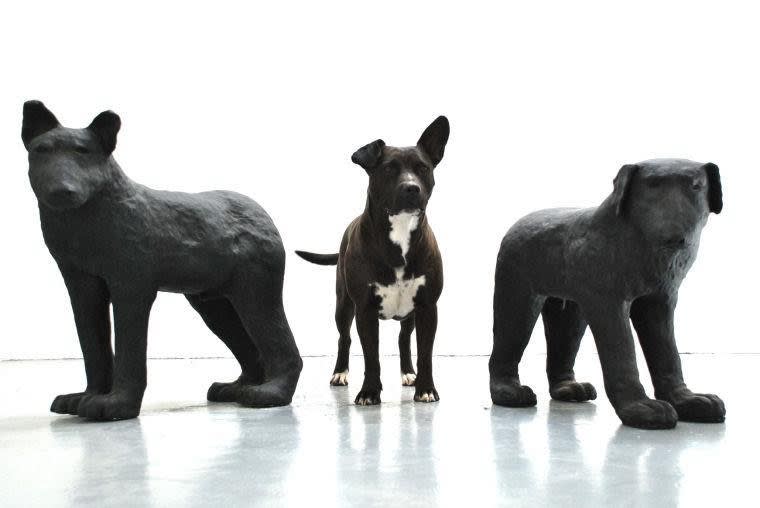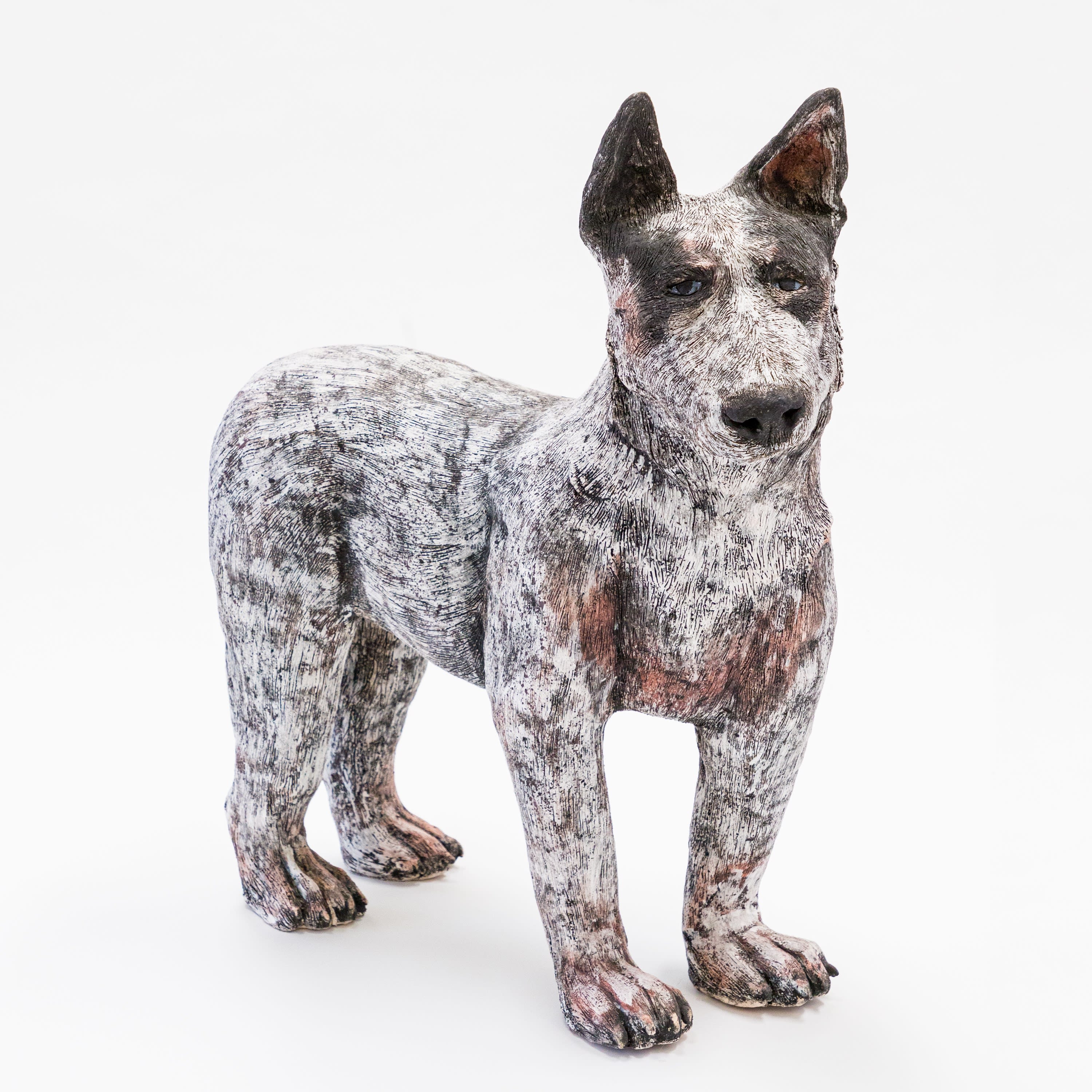
"Dogs are my subject, man. They’re the only thing that makes total sense to me." Santa Fe artist Joyce Stolaroff discusses her special connection to dogs and how she allows emotion to rule in her beloved series of ceramic dog characters.
Joyce Stolaroff, Hear US
Tell me about your very first dog.
My first dog was a little cocker spaniel mix. I think I was maybe 10 when I got her. I had always wanted a dog—and this wasn’t just your typical “little girl wanting a dog.” It was more than that. I would ride my bike to the next town over every single day to visit this schnauzer at a pet store.
The owner of the store called my mom and said, “What’s your problem? Obviously your daughter wants this dog.” She said no. I was never allowed to adopt that pet shop dog. It wasn’t until two or three years later that my parents finally allowed me to get my first dog. I had her for eight years, and then she was hit by a car and killed. That was really awful, and it was the first time I ever saw my dad cry. We all loved her a lot.
What a lovely story, and what a terribly traumatic ending! What was it about dogs that really drew you to them early on?
I was always shy, and that’s not a big deal, a lot of kids are shy. But I found this connection with dogs. The dog was always happy to see me. They’re so cute, and they just unconditionally love you. I really felt that. I didn’t necessarily feel that from other relationships in my life at the time, so I felt it from this dog.
Joyce Stolaroff, Y?
And that passion has only grown throughout your life, clearly!
I feel that to this day. I just adopted this new dog at the beginning of the pandemic. It was the weekend when there was all this buzz in New Mexico that we had a case of Covid. I found this dog at the Albuquerque shelter. It was an instant connection. It’s a love that grows everyday.
So I have two dogs now, and one is much more independent. She’s in the house right now sleeping in her cave, and one is literally in my lap. He doesn’t like technology because it takes time away from him. They’ve really filled a huge void during this time especially. I have somebody to talk to. I’m very fortunate that I don’t have to go out right now.
Speaking of the pandemic, how are you maintaining your artistic practice in this cloistered time?
I’m not making quite as much right now, because I don’t have a clay facility. I’m painting a bit. My house has become my sculpture, and I’m moving a lot of things around and getting rid of some things I’ve been carrying around for years. I’ve very much adjusted to this whole thing more successfully than a lot of people. I get total joy when I see people now. I used to not care as much, but you just don’t take anything for granted anymore.
Joyce Stolaroff, Phantom
You used to make art over at Santa Fe Community College. Have you been missing that setting and community?
It’s really an undiscovered jewel over there. The clay department is incredible. I moved back here 9 or 10 years ago, and about six months later I ended up over there. I had never really worked in clay, but someone told me, “I’m taking a clay class.” And I just did it with them.
The clay world is split up into different parts. There’s people who make functional pottery, and people who do production. Then there are the sculptural people. It’s special how this one medium can be embraced in so many different ways and by different personality types. I use clay for expression and not utility. There’s enough bowls in the world, let somebody else do it.
I’m surprised that my ceramic work took off. I’m very surprised that it took over painting and printmaking, because that’s all I’ve ever done in my whole life. Suddenly this medium showed up, and it was a perfect medium for dogs.
Why dogs?
Dogs are my subject, man. They’re the only thing that makes total sense to me. The clay allows for so much flexibility, to talk about them, to manipulate them. It keeps moving, whereas painting is more stagnant to me. I can’t move paint as much.
Dogs don’t let you down. I love that I can stand back and walk around them and they have a real presence. People notice them. They almost notice them more in the clay than they do in real life, weirdly. Not me, I’ll stop on the street to pet any dogs. But I’ve noticed that people really stop and look at the sculptures. That might be my ultimate goal, is to make people stop and think.

Joyce Stolaroff, Y? (detail)
Your dogs feel so alive, and they have this incredible emotional range. How do you capture that?
In my art, I definitely project feelings and responses to what’s going on in the world. They carry my energy, and I try to convey that in my work. I like using dogs to talk about situations in the world that either are right or not right. Usually things are not right lately.
Speaking of art that talks about real-world issues, could you tell me about your 2014 series of black dogs? As Michael Abatemarco wrote in Pasatiempo at the time, the series “calls attention to the plight of big black dogs who have slim chances of being adopted at shelters and face large rates of euthanization—a phenomenon known as black-dog syndrome.”
That was such a big project for me. It took a year and a half to do. There were 13 of them, which was a really powerful visual. When it was finally seen in public, I was pretty overwhelmed with the response.
Right away there was that immediate attraction from people, and then I’d talk to them and explain why it existed. I think it really struck people. I think people learned something, and people want to learn something. It wasn’t like picking up a book or taking a math class, it was this immediate emotional reaction. These dogs are being killed, and people understand that.
One thing I’ve found with the subject matter in general is that it is also a glue for people to connect to other people, even though there’s a second entity. It’s not people to people, it’s people to dogs to people.
How do you approach a new piece? Do you know exactly what you want to make?
I don’t think a lot when I do them, it’s just pure emotion, really. I think I’m still learning how to use the clay, which is so good because then I don’t have to think. I don’t want to have to worry about the material. I want to get right to the heart of it, to the gut, to what I want my image or my project to convey. I feel more free with that, and I have to thank collectors and my clay community because they’ve been very supportive.
Frankie with ceramic sculptures from Black Dog Down, 2014 (Pasatiempo)
That does sound liberating!
I feel like I can’t do any wrong with it. I feel like clay and I have become a partner, even though I know nothing about clay. People will talk technically about clay all day long. Glazing, firing techniques, processing. No, I don’t care about any of that. I just care about that rawness of conveying emotion. I really feel as though clay is the perfect medium for that. It’s pretty quick, and because it’s so malleable, you can put a smile or a frown on something in five seconds. I do like the instant gratification of it.
When you put it like that, it seems like it has to be really tough to not have regular access to a kiln these days.
Working in a solitary environment really isn’t good for clay people. My pieces are big, and you need two or three people to load them into the kiln. At SFCC, everybody’s willing. It’s the most wonderful experience. You have to communicate. Something as simple as coordinating time with other people really creates a sense of family and community. You really learn to take the good from every situation.
I miss it a lot. When I don’t do it, I feel like I don’t know how to do it anymore. When I do it again, it’s like, “Oh yeah!” It just comes back. Thankfully I’ve had good instructors that take that doubt away. They’ll say, “Your work’s not perfect, you don’t want it to be perfect.” It’s kind of like outsider art—it doesn’t stay in the lines. Outsider art is untrained art. I embrace that title, I find it’s a huge compliment. I feel like I have a really strong style with it, I don’t think the style will change.
Is the experience of this pandemic starting to influence your subject matter?
Everything is connected. Right before Covid hit, I started a whole series of couples. I like the connection between them. Something I always strive for is connecting with the audience, but when the elements within the piece of art connect with each other, I kind of like that direction too. There’s a mutual love and dependence and care, and the feeling that we’re not alone. Sometimes you have to carry someone who’s smaller or weaker. As a community, I think we have to do that.
In Judaism, you’re supposed to give your money away after you die, so that nobody can thank you. What a powerful thing. We just have to take care of each other, that’s what it comes down to. Even though we’re all separate right now, there has to be things that we can do.
Joyce Stolaroff, Heeler
Finally, what’s the story of your new dog?
He was three years old, and someone threw him away. When I decided I wanted him, they gave me his paperwork. I asked, “Why did these people get rid of him?” They said, “He runs away, he eats their house, and he would never go in the car.” I said, “Okay, those are all pretty minor, I can deal with that.” He was morbidly obese when he came into the shelter, and he was a skeleton when I got him. He was so stressed. He was running away because he wasn’t neutered. I addressed all of those issues, and he hasn’t had any of those problems since. You just have to give them time and consideration. Works for humans as well.




